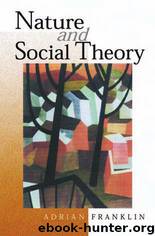Nature and Social Theory by Unknown

Author:Unknown
Language: eng
Format: mobi
Published: 2013-03-19T17:29:11+00:00
HYBRIDITY
145
FIGURE 6.1
Digging the garden (Source: Adrian Franklin) knowing the natural world outside its daily orbit. It was through their gardens perhaps that the irony is resolved: possibility of urban culture was rendered bearable only by a universal passion for gardening.
Urban gardening
The gardening revolution of the sixteenth to eighteenth centuries in England did not merely produce an abstract floricultural aesthetic: it had 146
NATURE AND SOCIAL THEORY
much wider social implications. Of particular note was its acceptance and approval as a rational, civilising and improving leisure, inculcating a sense of beauty but also of order. Second, gardening was particularly appealing to townsfolk, tempering and modifying the break with those ancient connections with the natural world resulting from the urbanisation of British society in the first half of the nineteenth century. Third, gardening became the medium for fashion and style in which the entire nation could, to a lesser or greater extent, participate. Rural life and that semi-rural life of the multitudinous small English towns held an almost unique aesthetic appeal among modernised nations. From the landscape wildernesses of Capability Brown to the miniaturised lawns and borders of the worker’s villa, the national passion for gardening and gardens and accompanying human–nature hybridity transcended class cultures and status groups. Although gardens were often the means by which the English created a sense of privacy around the domestic space, there was also a sense in which the garden was a public space, largely open to the public gaze, if not for public visiting. The public face of an English household was first and foremost its garden and it was through the garden far more than the interior that the different classes became familiar with each other and that social emulation via recruitment to a gardening aesthetic became possible.
The association of gardening with respectability and moral decorum was established very early on. Nothing could recommend it more strongly that John Lawrence’s The Clergyman’s Recreation of 1714. Far from inculcating a sense of guilt for so much time given over to leisure gardening Lawrence was ‘not in the least ashamed’: To say and own, that most of the time I can spare from the necessary care and business of a large Parish, and from my other studies, is spent in my garden and making observations towards the further improvement thereof. For I thank God this sort of diversion has tended very much to the ease and quiet of my own mind; and the retirement I find therein, by walking and meditation, has help’d to set forward many useful thoughts upon more divine subjects.
(Sinclair Rohde and Parker 1939:254)
Although the passion for gardening as leisure was new to early modern England, the idea of the garden as holy or sacred place has ancient roots, not least in the idea of the Garden of Eden as a place of original perfection.
The association of gardening as leisure with moral and spiritual improvement was suggested at least by the late seventeenth century. William Hughes, for example, suggests that although we fall from grace
Download
This site does not store any files on its server. We only index and link to content provided by other sites. Please contact the content providers to delete copyright contents if any and email us, we'll remove relevant links or contents immediately.
Kathy Andrews Collection by Kathy Andrews(10510)
The remains of the day by Kazuo Ishiguro(7544)
Spare by Prince Harry The Duke of Sussex(4188)
Paper Towns by Green John(4165)
The Body: A Guide for Occupants by Bill Bryson(3791)
Be in a Treehouse by Pete Nelson(3207)
Harry Potter and the Goblet Of Fire by J.K. Rowling(3026)
Goodbye Paradise(2951)
Never by Ken Follett(2873)
Into Thin Air by Jon Krakauer(2695)
The Remains of the Day by Kazuo Ishiguro(2614)
The Genius of Japanese Carpentry by Azby Brown(2602)
The Cellar by Natasha Preston(2592)
Drawing Shortcuts: Developing Quick Drawing Skills Using Today's Technology by Leggitt Jim(2529)
120 Days of Sodom by Marquis de Sade(2428)
Architecture 101 by Nicole Bridge(2348)
The Man Who Died Twice by Richard Osman(2291)
Machine Learning at Scale with H2O by Gregory Keys | David Whiting(2269)
Fairy Tale by Stephen King(2059)
